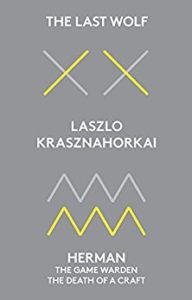
In any discussion of László Krasznahorkai’s work, it’s standard to first explain a few things about his style and place in European literature, as though with each new book we are being introduced for the first time to the writer Susan Sontag memorably (perhaps a little too quotably) called “the contemporary Hungarian master of the apocalypse.” George Szirtes described his sentences as a “slow lava flow of narrative, a vast black river of type.” His work is often seen as being in the mould of “European bleak,” placing him in a canon with Thomas Bernhard, Samuel Beckett, and W. G. Sebald.
But to take these cursory portraits at face value is to miss an important point about a living writer whose work is still evolving. Sontag’s quote is from her blurb for Krasznahorkai’s first work published in English, The Melancholy of Resistance (1989). And while the “lava flow” continues undammed in his latest work, its course has become less torrential and more fragile, expansive. The image of Krasznahorkai as a doomsayer overshadows the finer touch and artistry of his later work.
I mention all of this precisely because Krasznahorkai’s transcendence from prophet of post-Communist gloom to poet of Capitalist alienation has never been made more apparent than in his latest book, translated into English as The Last Wolf & Herman.
Two novellas make up the book. The first was written in 2009 and translated by George Szirtes, the second written in 1986 and translated in 2016 by John Batki. Krasznahorkai himself offered Herman as a companion piece to The Last Wolf when Barbara Epler, president and publisher of New Directions, asked him for a complimentary text, as The Last Wolf alone would be too thin (it’s seventy-two pages in English) to publish.
In The Last Wolf a man sits in the Sparschwein drinking a glass of Sternburg, recounting to a Hungarian bartender—who is often bored, sometimes asleep, but occasionally alert—a story about how he came to be employed by a mysterious “foundation” in Extremadura, after he had received an invitation to go, all expenses paid, and write anything he liked about the place. The narrator is a little-known Herr Professor, whose obscure work in analytic philosophy has kept him in the dark. That anyone knew of him, let alone invited him as a guest or writer-in-residence, he finds unbelievable—as he explains to the bartender in the first pages of the novella.
Displaying a masterly sleight-of-hand, the narration shifts from his story of the journey itself, after he has returned from Extremadura to the Sparschwein. He recounts his trip, explains how—accompanied by a dedicated translator and guide from the “foundation”—he spoke to people in many areas, searching for a subject to write about. Remembering a reference to the last wolf, his subject finally starts to take shape. “It was south of the River Duero in 1983 that the last wolf had perished…” This quote pinballs the expedition across Extremadura in search of the truth about the last wolf. We meet the hunters who claim to have shot the last wolf and get closer to the landscape—perfect terrain for Krasznahorkai—with its desert quality, isolated fincas, and sparse population.
Hunters and the hunted are the threads that stitch the two novellas together. But while the first novella is a subtle fugue on extinction, the second bludgeons the reader with Krasznahorkai’s younger tendency towards nihilistic contraptions, explosive rage, and always—most strikingly in The Melancholy of Resistance—mania and violence.
In a small village, the eponymous Herman is a warden tasked with making a seemingly unmanageable wooded area habitable. To do this he lays traps for the animals and buries them in pits, which, as time goes on, becomes fuller, smelling of death and driving Herman to despair. Eventually Herman turns his skills on the community that employed him.
There are two versions of Herman. The first is told by an omnipotent narrator. The second is narrated by a Krasznahorkai stand-in. He is a member of a nihilistic cult, revelling in Manson-esque fantasies and practices, who could have walked straight out of Satantango, inspired by the ego of Irimias. Herman has caused panic and hysteria in the town, fitting the early motifs of mob paranoia, murder, violence and control at the heart of The Melancholy of Resistance.
Vastness does not always mean an abyss. In Satantango, Irimias, in response to witnessing a Swedenborgian resurrection, could only say: “It doesn’t matter what we saw just now, it still means nothing. Heaven? Hell? The afterlife? All nothing. Just a waste of time. The imagination never stops working but we’re not one jot nearer the truth.” This same contrast between imagination and truth cleaves the two novellas.
It’s a shame New Directions didn’t publish The Last Wolf on its own. While the two pieces are thematically linked, The Last Wolf speaks for itself. Categorizations such as apocalyptic, bleak, and nihilistic work against artists like Krasznahorkai, who never stop evolving, who write to transcend the modes and fashions they occupy in the literary marketplace.




